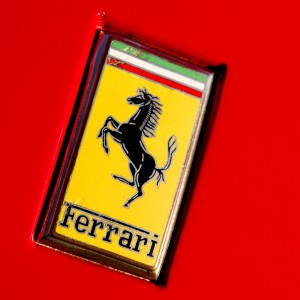 My eyelids sprang open, and I glanced at the alarm clock hoping it was at least 5:00 AM. Unfortunately, it read 2:46. I would need more sleep, but I felt like I just slammed back an espresso doppio. 3:08…3:37…. Be still. Relax. Breathe. 3:44…4:09…. In and out of sleep now, tossing and turning. Finally, the alarm sounded. It was 6:15, time to rise and collect my gear. I made a pot of coffee, filled two travel mugs with the stuff, and waited for photographer Dave May to show up. Vintage Ferrari day had finally arrived.
My eyelids sprang open, and I glanced at the alarm clock hoping it was at least 5:00 AM. Unfortunately, it read 2:46. I would need more sleep, but I felt like I just slammed back an espresso doppio. 3:08…3:37…. Be still. Relax. Breathe. 3:44…4:09…. In and out of sleep now, tossing and turning. Finally, the alarm sounded. It was 6:15, time to rise and collect my gear. I made a pot of coffee, filled two travel mugs with the stuff, and waited for photographer Dave May to show up. Vintage Ferrari day had finally arrived.
I directed Dave on where to turn, guessing at the correct route as I scrolled through emails on my phone, trying to find the owner’s address. An unnecessary task, since we soon found we were on the right track. In a driveway clearly visible from the street sat two vintage Ferraris in front of a three-car garage. A newer car, also emblazoned with a Prancing Horse emblem, still sat behind the third door of the garage. But this day was all about 1972, the year the owner’s 246 GT Dino and 365 GTB/4 Daytona left Maranello. Both cars, of course, are 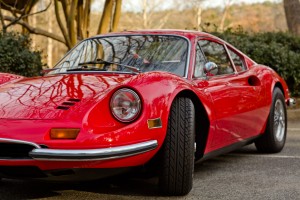 finished in Rosso Corsa paint. However, we’d soon find out that, despite their commonalities, they are two very different machines.
finished in Rosso Corsa paint. However, we’d soon find out that, despite their commonalities, they are two very different machines.
The owner showed us around his home, a residence almost as spectacular as the view from the hillside on which it sits. I tried to enjoy it, but was shaking from the cold weather for which I hadn’t dressed properly as well as from the anticipation of getting behind the wheel of two spectacular automobiles. Images of each were pinned to the walls of my boyhood bedroom. I’d waited a long time for the opportunity that this day brought.
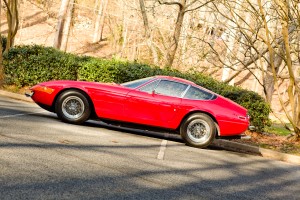 Back outside, we stood by the cars, taking in their beauty and contrasting lines. The Dino is a throwback, with big rounded fenders, scalloped to house the headlamps. Still, the 246 pointed toward the future upon its introduction in the late sixties. The Dino was Maranello’s first mid-engined road car, a trend that would become typical of Ferrari. By comparison, the 365 GTB/4 is big and modern in style. A true grand tourer, the Daytona (a name given to the car by the automotive press in recognition of Ferrari’s 1-2-3 sweep of the 1967 24-hour race in Florida) has a long, flat hood and a fast rear glass. Both wear Borani wire knock-offs, although the Dino was originally fitted with mags.
Back outside, we stood by the cars, taking in their beauty and contrasting lines. The Dino is a throwback, with big rounded fenders, scalloped to house the headlamps. Still, the 246 pointed toward the future upon its introduction in the late sixties. The Dino was Maranello’s first mid-engined road car, a trend that would become typical of Ferrari. By comparison, the 365 GTB/4 is big and modern in style. A true grand tourer, the Daytona (a name given to the car by the automotive press in recognition of Ferrari’s 1-2-3 sweep of the 1967 24-hour race in Florida) has a long, flat hood and a fast rear glass. Both wear Borani wire knock-offs, although the Dino was originally fitted with mags.
The plan was to caravan to our predetermined 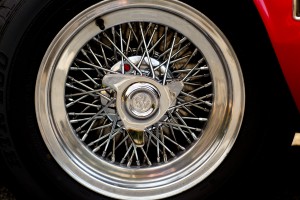 photography location next to the firehouse in the tiny municipality of Mountain Park, Georgia. It was decided that I would start off in the V6-powered Dino, since it’s the easier of the two to handle.
photography location next to the firehouse in the tiny municipality of Mountain Park, Georgia. It was decided that I would start off in the V6-powered Dino, since it’s the easier of the two to handle.
“I don’t even let my own children drive these cars,” the owner said.
“I’m nervous,” I admitted.
“So am I,” he replied. I wondered if I would be so generous if I were in his shoes.
Ready to ride, I slid down into the black leather seat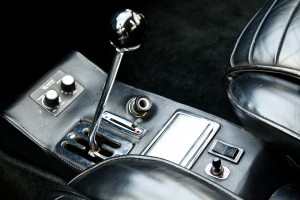 and quickly familiarized myself with the controls. The only other Ferrari I’d ever driven was a late-model example with a paddle-shifted F1 transmission. I looked down at the sexy aluminum gate at the base of the shift lever, a detail I’ve always admired. I’d long dreamed of rowing through the gears of a Dino. It’s not the most powerful or fastest of Enzo and company’s creations, but it has always remained a favorite, thanks in part to its gorgeous styling.
and quickly familiarized myself with the controls. The only other Ferrari I’d ever driven was a late-model example with a paddle-shifted F1 transmission. I looked down at the sexy aluminum gate at the base of the shift lever, a detail I’ve always admired. I’d long dreamed of rowing through the gears of a Dino. It’s not the most powerful or fastest of Enzo and company’s creations, but it has always remained a favorite, thanks in part to its gorgeous styling.
I led, followed by the owner in the Daytona. We started up the driveway and onto the neighborhood street. “Careful transitioning off the driveway, Nick. Easy does it,” I cautioned myself.
Before turning onto the main road, the Dino’s 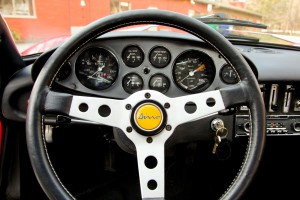 windshield became hazed with fog. Like the Daytona, the Dino is equipped with air conditioning. After a few seconds of trying to determine how to turn the fan on, I instead looked to the door panel to lower the window a bit, but no crank could be found. I quickly discovered the switch on the center console, surprised this 40-year-old, “cheap” Dino had power windows.
windshield became hazed with fog. Like the Daytona, the Dino is equipped with air conditioning. After a few seconds of trying to determine how to turn the fan on, I instead looked to the door panel to lower the window a bit, but no crank could be found. I quickly discovered the switch on the center console, surprised this 40-year-old, “cheap” Dino had power windows.
Is the Dino inexpensive? Certainly not. But when it 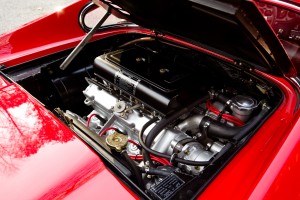 was introduced in 1968, the first Dino, the 206 GT model, was intended to compete with more accessible cars like the Porsche 911 and was given its moniker to differentiate it from the “true” 12-cylinder Ferraris. Alfredo “Dino” Ferrari, the son of founder Enzo Ferrari, was credited with designing the V6 motor, a job that historians now believe was actually accomplished by other engineers, notably Vittorio Jano. Dino died at the age of 24 from muscular dystrophy in 1956, long before his name became a brand. While “Dino” emblems grace the hood and steering wheel center of this particular example, a “Ferrari” chrome badge is mounted on the tail. The owner says that these were often added by Ferrari dealers to assign the prestigious name to these “lesser” cars.
was introduced in 1968, the first Dino, the 206 GT model, was intended to compete with more accessible cars like the Porsche 911 and was given its moniker to differentiate it from the “true” 12-cylinder Ferraris. Alfredo “Dino” Ferrari, the son of founder Enzo Ferrari, was credited with designing the V6 motor, a job that historians now believe was actually accomplished by other engineers, notably Vittorio Jano. Dino died at the age of 24 from muscular dystrophy in 1956, long before his name became a brand. While “Dino” emblems grace the hood and steering wheel center of this particular example, a “Ferrari” chrome badge is mounted on the tail. The owner says that these were often added by Ferrari dealers to assign the prestigious name to these “lesser” cars.
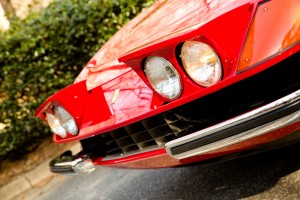 Once on location, the owner and I stood by, munching on homemade muffins my wife sent along and admiring the vehicles, as Dave meticulously captured each car with his camera. The owner talked a little about his treasured finds. Both are in fabulous original condition, each with around 50,000 miles on their odometers. Even the paint is original on both. The owner believes that cars are meant to be driven, and he practices what he preaches, taking the vehicles out of the garage and onto the road regularly.
Once on location, the owner and I stood by, munching on homemade muffins my wife sent along and admiring the vehicles, as Dave meticulously captured each car with his camera. The owner talked a little about his treasured finds. Both are in fabulous original condition, each with around 50,000 miles on their odometers. Even the paint is original on both. The owner believes that cars are meant to be driven, and he practices what he preaches, taking the vehicles out of the garage and onto the road regularly.
Upon completing the still photography, Dave and I jumped into the Dino so he could shoot some in-car video. Our location was not ideal for this purpose – too many stop signs and speed bumps – but it was still a joy to become more comfortable behind the wheel of the Dino. It’s a very easy car to drive, and the exhaust note is like music.
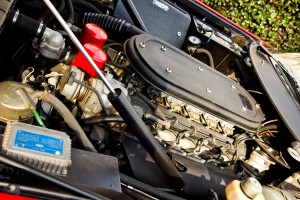 The Daytona is a different kind of machine. When new, the 365 GTB/4 was at the opposite end of Ferrari’s road-going offerings. It was the fastest production car in the world, its 4.3-liter, dual overhead cam V12 fitted with six, twin-choke Weber carburetors and capable of producing 352 horsepower. The Daytona could reach a top speed of 174 miles per hour. The owner emphasized the distinction between the Daytona and the Dino by explaining the Daytona wants to go very fast in a straight line, while the Dino is at home on twisty mountain roads.
The Daytona is a different kind of machine. When new, the 365 GTB/4 was at the opposite end of Ferrari’s road-going offerings. It was the fastest production car in the world, its 4.3-liter, dual overhead cam V12 fitted with six, twin-choke Weber carburetors and capable of producing 352 horsepower. The Daytona could reach a top speed of 174 miles per hour. The owner emphasized the distinction between the Daytona and the Dino by explaining the Daytona wants to go very fast in a straight line, while the Dino is at home on twisty mountain roads.
I climbed into the Daytona for some in-car video. As expected, the experience behind the wheel of the 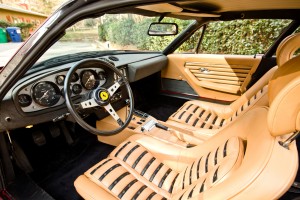 Daytona is markedly different from that of the 246 GT. While the cabin of the Dino is forward to accommodate the mid-engine design, the Daytona’s long hood seems to go on and on. Both cars lack power steering, but the front-engine Daytona’s steering is very heavy at low speeds. Its transmission was trickier than the Dino’s, too. If our twisty route with narrow lanes was tight for the Dino, it was wholly inappropriate for the big Daytona. The excellence of this machine was clearly apparent, but I was in the wrong location to really enjoy it. In fact, my most exciting experience with this Ferrari would come not from being behind the wheel, but experiencing it from the driver’s seat of the Dino.
Daytona is markedly different from that of the 246 GT. While the cabin of the Dino is forward to accommodate the mid-engine design, the Daytona’s long hood seems to go on and on. Both cars lack power steering, but the front-engine Daytona’s steering is very heavy at low speeds. Its transmission was trickier than the Dino’s, too. If our twisty route with narrow lanes was tight for the Dino, it was wholly inappropriate for the big Daytona. The excellence of this machine was clearly apparent, but I was in the wrong location to really enjoy it. In fact, my most exciting experience with this Ferrari would come not from being behind the wheel, but experiencing it from the driver’s seat of the Dino.
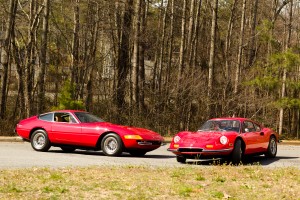 That moment came when we left the photography location. I led again in the Dino, the owner following in the Daytona. The temperature had risen, so I lowered the driver-side window. We reached the end of a two-lane road and turned onto a wide, divided highway. As I accelerated toward the 45 mph speed limit, the Daytona came up on my left, its V12 screaming and its owner grinning at me as he passed. A smile came across my face where it remained for the balance of the journey. Feeling more comfortable now after some experience with the Dino, I followed the Daytona at quick speed but a safe distance, making every effort to enjoy my final minutes behind the wheel of this spectacular machine.
That moment came when we left the photography location. I led again in the Dino, the owner following in the Daytona. The temperature had risen, so I lowered the driver-side window. We reached the end of a two-lane road and turned onto a wide, divided highway. As I accelerated toward the 45 mph speed limit, the Daytona came up on my left, its V12 screaming and its owner grinning at me as he passed. A smile came across my face where it remained for the balance of the journey. Feeling more comfortable now after some experience with the Dino, I followed the Daytona at quick speed but a safe distance, making every effort to enjoy my final minutes behind the wheel of this spectacular machine.
The six-cylinder 246 GT Dino seems every bit the authentic Ferrari that the V12 365 GTB/4 is. If it isn’t,  well, both Dinos and Ferraris are among my favorite cars ever made. Very few people get the privilege of experiencing even one of these fantastic machines. I may not ever have the means to afford one myself, but I know that I am extremely fortunate to have enjoyed the thrilling 246 GT Dino and the breathtaking 365 GTB/4. A dream come true, indeed.
well, both Dinos and Ferraris are among my favorite cars ever made. Very few people get the privilege of experiencing even one of these fantastic machines. I may not ever have the means to afford one myself, but I know that I am extremely fortunate to have enjoyed the thrilling 246 GT Dino and the breathtaking 365 GTB/4. A dream come true, indeed.


Pingback: Honda Odyssey & Subaru Forester: A Word About Our Family Cars | Nick Palermo, Freelance Auto Writer |Living Vroom()
Pingback: Moving Forward: automotive photography | Dave May PhotographyDave May Photography()
Pingback: Moving Forward: automotive photography | Dave May Photography()